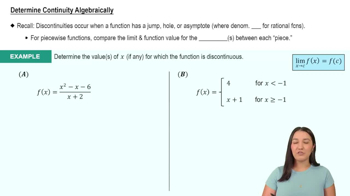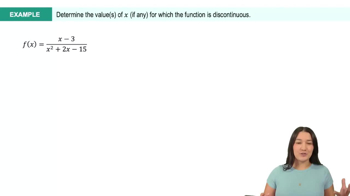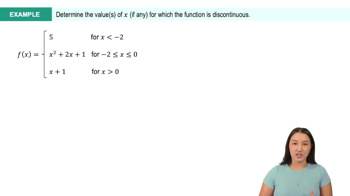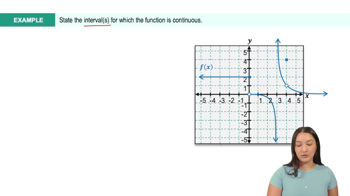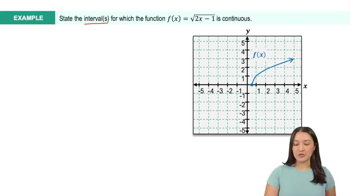Table of contents
- 0. Functions7h 52m
- Introduction to Functions16m
- Piecewise Functions10m
- Properties of Functions9m
- Common Functions1h 8m
- Transformations5m
- Combining Functions27m
- Exponent rules32m
- Exponential Functions28m
- Logarithmic Functions24m
- Properties of Logarithms34m
- Exponential & Logarithmic Equations35m
- Introduction to Trigonometric Functions38m
- Graphs of Trigonometric Functions44m
- Trigonometric Identities47m
- Inverse Trigonometric Functions48m
- 1. Limits and Continuity2h 2m
- 2. Intro to Derivatives1h 33m
- 3. Techniques of Differentiation3h 18m
- 4. Applications of Derivatives2h 38m
- 5. Graphical Applications of Derivatives6h 2m
- 6. Derivatives of Inverse, Exponential, & Logarithmic Functions2h 37m
- 7. Antiderivatives & Indefinite Integrals1h 26m
- 8. Definite Integrals4h 44m
- 9. Graphical Applications of Integrals2h 27m
- 10. Physics Applications of Integrals 2h 22m
1. Limits and Continuity
Continuity
Problem 34
Textbook Question
[Technology Exercise] In Exercises 33–36, graph the function to see whether it appears to have a continuous extension to the given point a. If it does, use Trace and Zoom to find a good candidate for the extended function’s value at a. If the function does not appear to have a continuous extension, can it be extended to be continuous from the right or left? If so, what do you think the extended function’s value should be?
g(θ) = 5 cos θ / (4θ ― 2π) , a = π/2
 Verified step by step guidance
Verified step by step guidance1
Identify the function given: \( g(\theta) = \frac{5 \cos \theta}{4\theta - 2\pi} \) and the point \( a = \frac{\pi}{2} \).
Check for continuity at \( a = \frac{\pi}{2} \) by substituting \( \theta = \frac{\pi}{2} \) into the denominator \( 4\theta - 2\pi \). If the denominator equals zero, the function is not defined at this point.
Since the denominator becomes zero at \( \theta = \frac{\pi}{2} \), the function is not defined at this point, indicating a potential discontinuity.
Use a graphing tool to plot \( g(\theta) \) and observe the behavior of the function as \( \theta \) approaches \( \frac{\pi}{2} \) from both the left and the right.
Determine if the function can be extended to be continuous from either the left or the right by observing the limit of \( g(\theta) \) as \( \theta \) approaches \( \frac{\pi}{2} \). If the left-hand limit and right-hand limit are equal, suggest this common value as the extended function's value at \( a = \frac{\pi}{2} \).
 Verified video answer for a similar problem:
Verified video answer for a similar problem:This video solution was recommended by our tutors as helpful for the problem above
Video duration:
9mPlay a video:
Was this helpful?
Key Concepts
Here are the essential concepts you must grasp in order to answer the question correctly.
Continuous Functions
A function is continuous at a point if the limit of the function as it approaches that point equals the function's value at that point. This means there are no breaks, jumps, or holes in the graph of the function at that point. Understanding continuity is crucial for determining whether a function can be extended to include a specific point.
Recommended video:

Intro to Continuity
Limits
The limit of a function describes the behavior of the function as it approaches a particular input value. It is essential for analyzing functions at points where they may not be defined or where they exhibit discontinuities. In this exercise, evaluating the limit of g(θ) as θ approaches π/2 will help determine if a continuous extension exists.
Recommended video:

One-Sided Limits
Right-Hand and Left-Hand Limits
Right-hand and left-hand limits refer to the values that a function approaches as the input approaches a specific point from the right (greater values) or the left (smaller values). These concepts are important for assessing whether a function can be extended continuously from one side, which is particularly relevant when the overall limit does not exist but one-sided limits do.
Recommended video:

Left, Right, & Midpoint Riemann Sums
Related Videos
Related Practice




